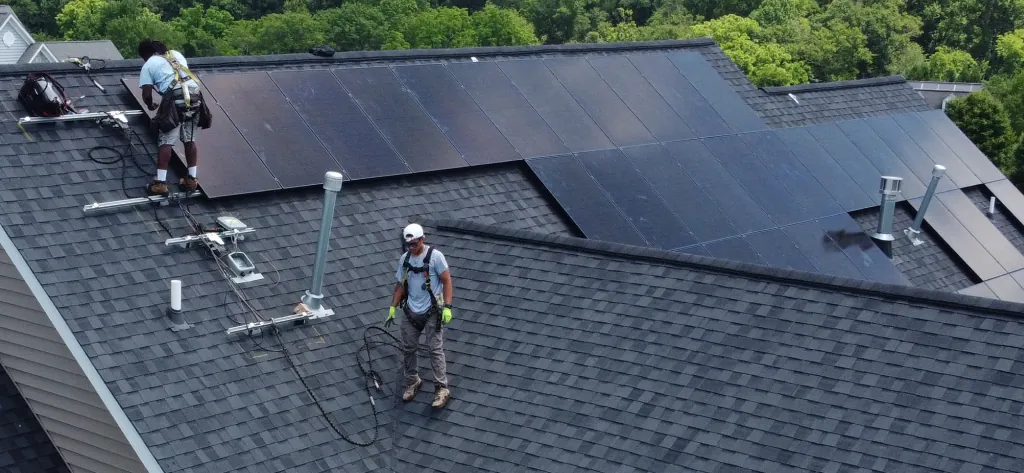Article
Can You Add Battery Storage to an Existing Solar System?

Many homeowners purchase a simple solar array with the goal of enhanced sustainability and lower energy bills, assuming that panels and an inverter are all they need to achieve these outcomes. Over time, they begin to wonder just how much more they could save – and how great of an environmental impact they could make – by adding battery storage to their solar energy system.
It turns out that solar batteries offer significant advantages over conventional arrays, including enhanced energy independence and more significant long-term savings. Discover what it takes to add a battery to an existing array, and how this addition can help you achieve a faster return on your investment.
Understanding Solar Battery Storage
Solar battery storage is a powerful enhancement for any residential PV array. Let’s dive into the basics:
What is Solar Battery Storage?
Standard solar panel systems capture sunlight in the form of direct-current energy, which is then converted to usable alternating-current power by an inverter. Then, that electricity is sent to your home’s electrical panel and dispersed as needed throughout your home. Energy that isn’t used right away is either sent back to the grid via net metering or lost entirely. A solar battery provides valuable storage space for this surplus energy, allowing you to save it for use when your panels are not actively generating clean energy, such as at night and during power outages.
If you aren’t seeing substantial savings with a basic solar panel array, battery storage may be the missing link.
Benefits of Solar Battery Storage
Whether a solar battery is part of your initial investment or you add a battery to an existing solar array, this accessory can amplify the advantages of renewable energy by making the electricity produced more accessible. Storing surplus power opens the door to greater energy independence, reduces your reliance on the grid, and protects you from volatile utility prices. Solar power backup also provides peace of mind during power outages. Grid-connected solar arrays without battery storage will shut down when they detect system interruptions to protect lineworkers and utility crews, but the right solar battery can give you access to stored energy during these times.
Enhanced savings are another key benefit of solar batteries. By utilizing more of the clean energy generated by your solar panels, you minimize the energy sourced from your utility provider. This practice can insulate you from peak-use rates and put more cash back in your pocket.
Seamless Integration with Existing Solar Systems
Solar battery storage can take your existing array to the next level, but the process requires careful coordination to integrate the various components of your system and ensure optimal performance.
How to Integrate Battery Storage with Existing Systems
Adding battery storage to an existing solar panel system requires a calibration process that starts with an assessment of your current setup. Your installation expert will evaluate your inverter, panel production, wiring, and other components to ensure compatibility with various batteries. If your existing inverter was not installed with a future battery in mind, you may need to upgrade to a hybrid inverter to streamline operations.
Once your solar tech has a solid understanding of your system, they can recommend compatible batteries to meet your needs. Depending on your goals, you may choose a single battery or a more extensive battery bank. Next, your specialist will obtain the necessary permits and approvals before proceeding with the installation process.
Types of Solar Batteries Available
You’ll find several types of solar batteries on the market, including:
Lead-Acid Batteries
Older lead-acid batteries are the most cost-effective option. However, they’re larger, less efficient, and have shorter lifespans, so you can expect to replace them more frequently than higher-quality models. These batteries also require a moderate amount of maintenance.
Lithium-Ion Batteries
Lithium-ion batteries are among the most popular types of solar power backup systems for residential use, offering high energy density, minimal maintenance requirements, and long lifespans. Thanks to fast charging and discharging processes, they’re great for daily cycling and energy storage. Examples include the Tesla Powerwall, Enphase IQ, FranklinWH aPower, and LG Chem.
Flow Batteries
Flow batteries are on the cutting edge of solar energy storage, using liquid electrolytes to store large amounts of energy. Currently, they’re primarily used in commercial arrays and large-scale residential systems, but we anticipate more widespread applications in the future. This technology features exceptionally long lifespans and fully scalable configurations.
Cost Considerations and Savings
Before you add solar battery storage to an existing array, consider how the long-term financial benefits can offset your initial investment.
Evaluating the Costs of Adding Battery Storage
The cost of adding a solar battery to an existing PV array depends on the type and size of storage you choose, the complexity of installation, and the compatibility of your inverter. While the average sticker price for residential solar power backup systems can range from $10,000 to $20,000, many rebates and financial incentives can lower your upfront expenses, including the Federal Solar Tax Credit, which reimburses homeowners up to 30% of the initial costs of renewable energy systems.
Since solar battery storage allows you to use more of the electricity your system generates, you’ll also compound the savings afforded by your existing solar setup. The more clean energy you store for later use, the faster you’ll see a return on your investment. Of course, you can still participate in net metering programs and sell Solar Renewable Energy Certificates (SRECs) with a solar battery, both of which can boost potential savings even more.
Substantial tax rebates and ongoing savings through reduced energy bills are among the most notable benefits of solar batteries, but they’re not the only financial incentives worth noting. Many states offer sales and use tax exemptions, property tax exemptions, and clean energy grants that apply to solar battery storage, further cutting costs.
Comprehensive Support and Warranties
A strong warranty and ongoing support are crucial when adding a battery to an existing solar array. Most solar battery warranties include performance guarantees, ensuring your device will retain a certain percentage of its original capacity over time. For example, they may promise your battery will hold at least 70% of the specified storage capacity after 10 years. These warranties should also cover defects in materials and workmanship. Throughput warranties are typically based on the amount of energy the battery can cycle through during its lifetime.
Smart solar batteries require software updates, performance monitoring, and timely troubleshooting from knowledgeable experts. As such, great customer support is important for long-term reliability.
Expert Guidance for Homeowners
Before you begin shopping for a solar battery storage system, it’s essential to consult with the company that initially installed your existing array. In many cases, reputable solar installation companies will not install solar batteries for PV arrays installed by another business. A secondary business may not have access to insights into past workmanship or installation standards, which can ensure the initial design is up to code. It’s challenging to ensure compatibility between panels, inverters, monitoring systems, and batteries without access to the original project specifications. Partnering with a third party to add a battery to an existing solar panel system can void your warranty and complicate future issues that arise.
At the end of the day, working with a solar panel company you know and trust for all your solar needs will simplify long-term maintenance and support, and improve performance for the lifespan of your array. That’s why you shouldn’t hire just anyone to install your solar panels.
Elevate Your Solar Experience with Solar Battery Storage
For many homeowners, solar battery storage is the key to enhanced savings and energy efficiency. Making the most of the energy generated by your PV system will further reduce monthly utility bills and offset the costs of your initial investment even faster. Ready to see how a solar battery can turbocharge your renewable energy system? The experts at Solar Energy World are here to help. Reach out today to get started!
Want a Free Solar Estimate?
Fill out the form to get started today.


